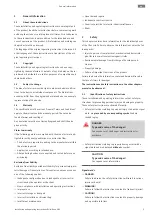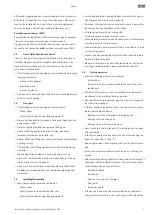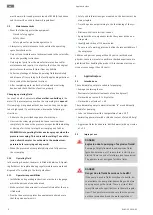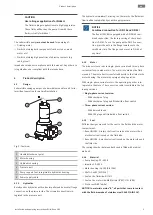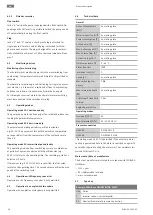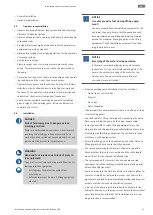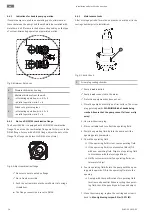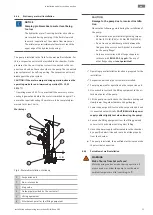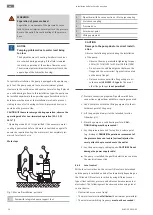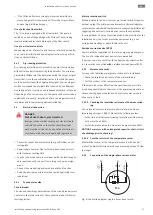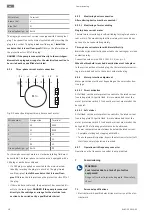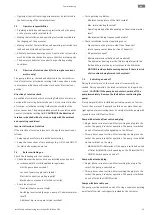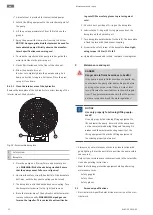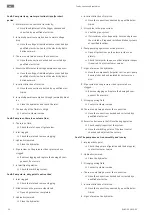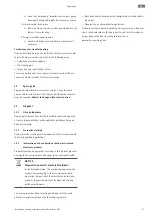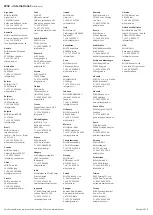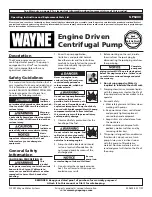
Commissioning
en
Installation and operating instructions Wilo-Rexa UNI
19
ƒ
Operation/control: Operating personnel must be instructed in
the functioning of the complete system.
7.2
Operator responsibilities
ƒ
Providing installation and operating instructions by the pump
or at a place specially reserved for it.
ƒ
Making the installation and operating instructions available in
the language of the personnel.
ƒ
Making sure that the installation and operating instructions are
read and understood by all personnel.
ƒ
All safety devices and emergency cut-outs on the system-side
must be active and checked to ensure that they work properly.
ƒ
The pump is suitable for use under the specified operating
conditions.
7.3
Direction of rotation check (for three-phase current
motors only)
The pump is factory-checked and adjusted to the correct direc-
tion of rotation for a clockwise rotating field. Connection is made
in accordance with the specifications in chapter “Electrical con-
nection”.
Direction of rotation check
A qualified electrician checks the rotating field at the mains con-
nection with a rotating field-test device. For the correct direction
of rotation, a clockwise rotating field must be available at the
mains connection. The pump is
not
approved for operation with a
counter-clockwise rotating field!
CAUTION! If the direction of
rotation is checked with a test run, comply with the ambient
and operating conditions!
Incorrect direction of rotation
If the direction of rotation is incorrect, change the connection as
follows:
ƒ
Swap two phases for motors with direct starting.
ƒ
Swap the connections of two windings (e.g. U1/V1 and U2/V2)
for star-delta activation motors.
7.4
Before switching on
Check the following prior to activation:
ƒ
Check whether the device has been installed properly and in
accordance with the locally applicable regulations:
–
Has the pump been earthed?
–
Layout of power supply cable tested?
–
Electrical connection made properly?
–
Mechanical components attached correctly?
ƒ
Check level control:
–
Float switches can move freely?
–
Switching level tested (pump on, pump off, minimum water
level)?
–
Additional dry-running protection installed?
ƒ
Test operating conditions:
–
Min./max. temperature of the fluid tested?
–
Max. immersion depth tested?
–
Operating mode defined depending on the minimum water
level?
–
Maximum switching frequency adhered to?
ƒ
Check installation location/operating space:
–
Pipe system on the pressure side free of deposits?
–
Inlet or pump sump cleaned or free of deposits?
–
All gate valves open?
–
Minimum water level defined and monitored?
The hydraulics housing must be filled completely with the
fluid and there must be no air cushions in the hydraulics.
NOTICE! Provide suitable venting devices if there is a risk
of air cushions being formed in the system!
7.5
Switching on and off
During the start process, the rated current is temporarily ex-
ceeded. During operation, the rated current may no longer be ex-
ceeded.
CAUTION! If the pump does not start, switch off the
pump immediately. Remove the fault before reactivating the
pump!
Place pumps which are installed as portable pumps on a firm sur-
face so they are level. If pumps have fallen over, place them up-
right again before activating them. Securely attach the pump with
screws in case of difficult surfaces.
Pump with attached float switch and plug
ƒ
Single-phase current version: After inserting the plug into the
socket, the pump is ready for operation. The pump is switched
on and off automatically depending on the fill level.
ƒ
Three-phase current version: After inserting the plug into the
socket, the pump is ready for operation. The pump is controlled
via two switches on the plug:
–
MANUAL/AUTO: Determines if the pump is switched on and
off directly (MANUAL) or depending on the fill level (AUTO).
–
ON/OFF: Switch pump on and off.
Pump with attached plug
ƒ
Single-phase current version: After inserting the plug in the
socket, the pump is switched on.
ƒ
Three-phase current version: After inserting the plug into the
socket, the pump is ready for operation. The pump is switched
on and off with the ON/OFF switch.
Pumps with bare cable end
The pump must be switched on and off using a separate operating
point (on/off switch, switchgear) provided by the customer.

